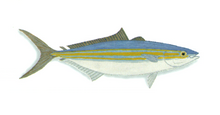纺缍𫚕
| 本条目近期正在扩充或大幅编修。 若本条目已数日无大修改,请移除本模板。 致添加本模板的编者:如须在短时间内大幅修改,请务必在编辑期间用 {{inuse}}或{{inuse2}}来取代本模板。本条目由Dewadipper(贡献·日志)于2小时前最后编辑。 |
纺缍𫚕(学名:Elagatis bipinnulata)又称双带鲹,俗名西班牙鲹、虹𫚕、夏威夷鲑、海草、拉仑,为辐鳍鱼纲鲈形目鲈亚目鲹科的其中一个种。
| 纺缍𫚕 | |
|---|---|

| |
| 科学分类 | |
| 界: | 动物界 Animalia |
| 门: | 脊索动物门 Chordata |
| 纲: | 辐鳍鱼纲 Actinopteri |
| 目: | 鲹形目 Carangiformes |
| 科: | 鲹科 Carangidae |
| 属: | 纺缍𫚕属 Elagatis |
| 种: | 纺缍𫚕 E. bipinnulata
|
| 二名法 | |
| Elagatis bipinnulata | |

| |
| 异名 | |
| |
物种命名
编辑纺锤𫚕于1825年由法国博物学家让·勒内·康斯特·盖伊和约瑟夫·保罗·盖玛德正式描述,正模标本产自印度洋马来群岛海域[1]。彼时命名人认为此种鱼应属于𫚕属,故将其命名为 Seriola bipinnulata。1831年,美国博物学家路易·阿加西将其拆至新属Micropteryx[2],但由于此属名已被用于小翅蛾属故未能得到接受[3]。至1840年,英国生物学家弗雷德里克·德贝尔·本内特在他的捕鲸航海日志中将纺锤𫚕划入新创建的纺锤𫚕属Elagatis,此分类维持至今[4]。本内特同时还将该种鱼的种加词改为“bipinnulatus”,但由于该词与属名的性不同并未得到采纳[5]。
物种分类
编辑分布
编辑本鱼广泛分布于全球各大洋的暖水域。
外貌描述
编辑纺锤𫚕头部长而尖,尾鳍根部狭窄,形如纺锤[7]。纺锤𫚕的。该鱼有背鳍两片,第一片一般有6根硬棘,第二片则有1根硬棘和25—30根软鳍条,其中最后2根软鳍条特化成独立的小鳍。约有4%的纺锤𫚕孵化时缺少一根硬棘[8] 。其臀鳍有2根硬棘和18—22根软条,其中最靠前的1根硬棘和最后方的2根软条亦特化成独立的小鳍[9]。纺锤𫚕的背鳍与臀鳍相当低矮,且前者远大于后者。该鱼胸鳍相比其他鲹科鱼类而言较小,大约与腹鳍等大,且不呈镰刀型,共有软条20根。其腹鳍有1根硬棘和5根分叉的软条。纺锤𫚕尾深叉,有上9下8共17根软条[8]。
深度
编辑水深0至30公尺。
特征
编辑本鱼体成纺锤形状;体背蓝黑色,腹面银白带浅蓝色调,体侧面有2条平行的浅蓝色纵带。胸鳍与腹鳍约略等长;尾鳍分叉极深;臀鳍及第二背鳍后方均有1枚带著2枚软条的离鳍。上下颔具有绒毛状齿,口腔和舌头上也有微小的牙齿。第一背鳍有硬棘6枚;第二背鳍有硬棘1枚、软条24至27枚;臀鳍有硬棘1枚、软条15至16枚。体长可达110公分,体重可达46.2公斤。
生态
编辑本鱼属于外洋性鱼类,绝少到沿岸水域,以小鱼及无脊椎动物为食。
经济利用
编辑肉硬可食,无腥味,适合各种料理。英文称作Rain bow runner是因为当上钩时,会跃出水面,水花映出彩虹般的光芒,故名,具有雪卡鱼毒的纪录。
参考文献
编辑- ^ Hosese, D.F.; Bray, D.J.; Paxton, J.R.; Alen, G.R. Zoological Catalogue of Australia Vol. 35 (2) Fishes. Sydney: CSIRO. 2007: 1150. ISBN 978-0-643-09334-8.
- ^ Micropteryx. WoRMS.
- ^ Gray, John Edward. List of the Specimens of British Animals in the Collection of the British Museum: Part VII - Lepidoptera. London: British Museum of Natural History. 1852: 24–25.
- ^ Meek, Seth E.; Bollman, Charles H. Note on Elagatis bipinnulatus. Proceedings of the Academy of Natural Sciences of Philadelphia (Academy of Natural Sciences). 1889, 41: 42–44.
- ^ Lin, Pai-Lei; Shao, Kwang-Tsao. A Review of the Carangid Fishes (Family Carangidae) From Taiwan with Descriptions of Four New Records. Zoological Studies. May 19, 1999, 38 (1): 33–68 [2007-11-15].
- ^ Reed, David L.; Carpenter, Kent E.; deGravelle, Martin J. Molecular systematics of the Jacks (Perciformes: Carangidae) based on mitochondrial cytochrome b sequences using parsimony, likelihood, and Bayesian approaches. Molecular Phylogenetics and Evolution. 2002, 23 (3): 513–524. Bibcode:2002MolPE..23..513R. PMID 12099802. doi:10.1016/S1055-7903(02)00036-2.
- ^ Carpenter, Kent E. Niem, Volker H. , 编. FAO species identification guide for fishery purposes. The living marine resources of the Western Central Pacific. Volume 5. Bony fishes part 3 (Menidae to Pomacentridae) (PDF). Rome: FAO. 2001: 2684. ISBN 978-92-5-104587-9.
- ^ 8.0 8.1 Berry, Frederick H. Elagatis bipinnulata (Pisces: Carangidae): Morphology of the Fins and Other Characters. Copeia. 1969, 1969 (3): 454–463. JSTOR 1441924. doi:10.2307/1441924.
- ^ McEachran, John D.; Fechhelm, Janice D. Fishes of the Gulf of Mexico: Myxiniformes to Gasterosteiformes. Austin: University of Texas Press. 1998: 285. ISBN 978-0-292-75206-1.
